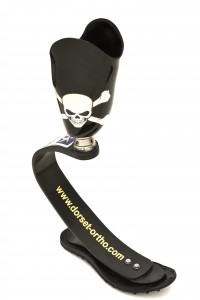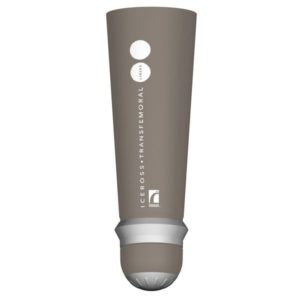Below knee prostheses
– Transtibial amputation
An amputation between the knee and ankle is known as a transtibial (across the tibia) amputation. Due to the bone being cut and muscle flaps formed to cover the end, it is not possible to bear weight through the end of the residual limb. So the socket must be shaped in a very specific way to allow the user to bear weight through other areas of the leg instead.
By adding a small ledge below the knee cap and shaping the socket to apply pressure to either side of the shin bone (tibia), a transtibial amputee is able to stand fully on their prosthetic limb with little to no discomfort. The tendon that attaches the knee cap to the shin bone (the patellar tendon) is very strong and can take a lot of force (think of trying to bend a metal bar by putting it across your knee).
There is a variety of different styles of transtibial prosthesis, and they can be made from plastic (polypropylene, fibreglass or carbon fibre), metal or even wood. Metal and wooden limbs are rarely seen these days with the majority of these prostheses manufactured from fibreglass. The socket is made from a plaster-of-Paris mould taken from your leg which gives a very precise fit for maximum comfort and support. The socket is usually fitted over a liner, either made from a firm foam or silicone rubber. The foam liner is pulled onto the limb, whereas the more flexible silicone liner is turned inside-out and then rolled onto the limb – the silicone liner was invented in Iceland which explains why it is known as the IceROSS system (Icelandic Roll-On Silicone Socket).
A number of methods can be used to hold the prosthesis onto the residual limb. If a foam liner is used, we can use either an elastic sleeve to grip around the thigh, or shape the socket to grip either side of the knee. Silicone liners are available with a small pin attached to the bottom which engages into a lock built into the socket, or with a rubber seal to create a vacuum within the socket. Your prosthetist will help you choose the best solution for you.
A prosthetic foot is attached to the socket to provide a prosthesis that is the correct height and is stable for walking. There are a range of different types, made from materials such as wood, rubber and carbon fibre. Some have moveable ankle joints and others have carbon fibre springs; some also have built-in shock absorbers for high activity uses, or adjustable ankles to allow you to wear high-heeled and flat shoes. Your prosthetist will work with you to choose the best components to suit your needs.
For more information or to make an appointment, please call APOS on 091 796983.


